There appears to be some concern about what is really going to happen when the new, residential unitary air conditioning efficiency regulations go into effect later this year so we put together a list of questions and answers to help HVAC contractors keep current on what they need to know about these new standards.
I heard the new regulations were being challenged in court. Will they get thrown out entirely?
Although there are some legal challenges to the exact implementation date, the next round of efficiency standards for residential air conditioning is still expected to apply to air conditioners and heat pumps installed on or after January 1, 2015. And, even if the challenges are successful in delaying the enforcement date by a few months, contractors should still try to become familiar with the structure of the new regulations because that is not likely to change. For example, there will actually be three, new minimum efficiency levels with the new regulations because the standards for air conditioning are different for the three specified geographic regions. For more information about the actual regulation you can click on the following link:
http://www.ac-heatingconnect.com/how-to-prepare-for-new-regional-efficiency-standards/
In 2005 there was a large build ahead of old, low efficiency systems. Will there be a build ahead like this in 2014?
In 2005, there was a build ahead of 10 SEER systems just prior to the 2006 implementation date. It is unlikely that there will be a build ahead of that magnitude since the move from 13 SEER to 14 SEER in 2015 will be less challenging than the 2006 move from 10 SEER to 13 SEER and the cost increases driven by the 2015 change will be much smaller. Also, since 13 SEER AC systems can still be sold into the northern region, there is less stress about having unsalable, low efficiency inventory around after the new regulations go into effect.
What product changes can we expect from these new regulations?
The most significant product change in 2015 will involve moving all split-system heat pumps in all regions to the new national heat pump efficiency minimum of 14 SEER and 8.2 HSPF. Since most, if not all U.S. manufacturers already have 14 SEER heat pump systems today, many are probably just refreshing their 14 SEER designs to optimize their product offerings for high volume. Depending on the outcome of the legal debate mentioned above, contractors can probably expect to see the planned elimination of 13 SEER heat pumps from OEM lines and an increased offering of new, low cost, 14 SEER heat pumps which should be available on time for 2015 stocking programs.
Will the yellow “hang-tag” efficiency labels be changing with the new regulations?
Yes. One consequence of the regional nature of AC standards is the change to the FTC energy guide label. This is the yellow label that is attached to the unit with SEER and HSPF rating of the unit shown in relation to the range of similar models. One change to this label is that it will not show just one rating point for split-system air conditioners and head pumps (i.e. systems that consist of an outdoor condenser and an indoor coil). Split-system air conditioners and heat pumps will now be shown as a range representing the lowest and highest SEER ratings for all of the condenser’s certified coil combinations Consider a unit with rated efficiency that can range from 13-14.5 SEER depending on the selection of the indoor system, blower and coil combinations. It is possible that this outdoor unit might have a suitable Indoor match which would allow it to be installed in all three regions. In this case, it would become important to track both the outdoor and indoor model numbers and check the rated system performance for each installation to ensure it is compliant with the new regulations.
Are there any tools we can use to determine if the indoor and outdoor equipment is qualified?
One useful tool to determine the matched system performance is the AHRI directory which contains the database of all system performance certifications (http://www.ahridirectory.org/ahridirectory/pages/home.aspx). By entering a few parameters like the outdoor and indoor model numbers you can determine the expected performance of the combination. The ruling on enforcement method is still pending, but it would be prudent for contractors to prepare for the eventual regulation changes by becoming familiar with this directory since it is likely that contractors are going to be involved with the process of insuring that the equipment they are installing meets the minimum regulations.
Do we know how the DOE is planning to enforce the new regulations?
Although the specific roles and responsibilities of the contractor, distributor and manufacturer are not defined yet, it is likely that all parties will be involved with some aspect of enforcement. In any case, contractors should be able to verify that the equipment being installed meets the minimum standards provided by the new regulations and also meets the expectations of the consumer.



